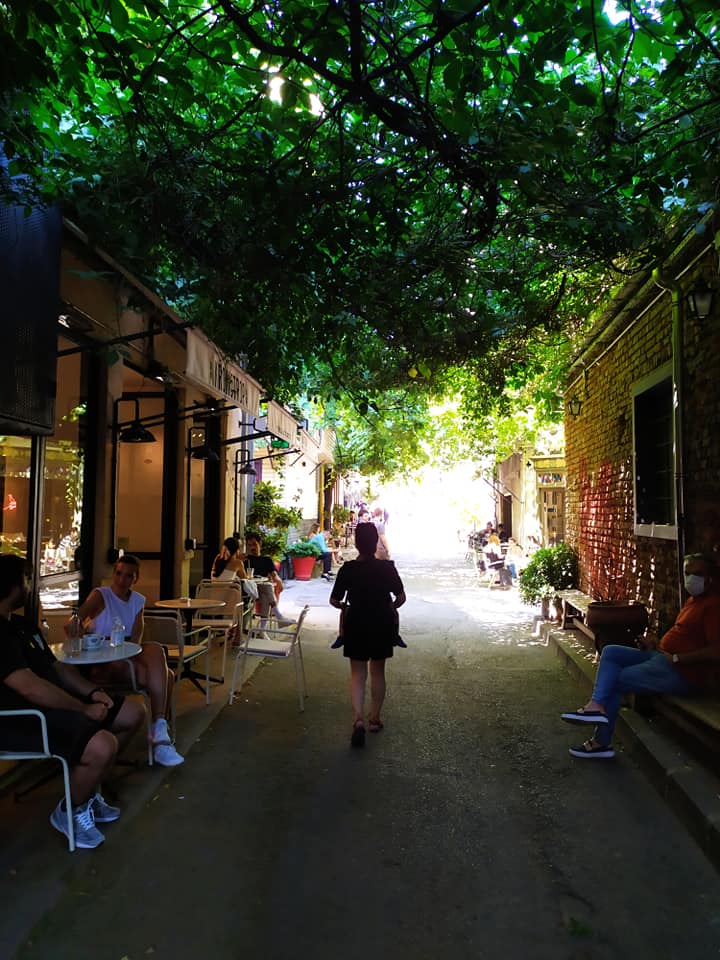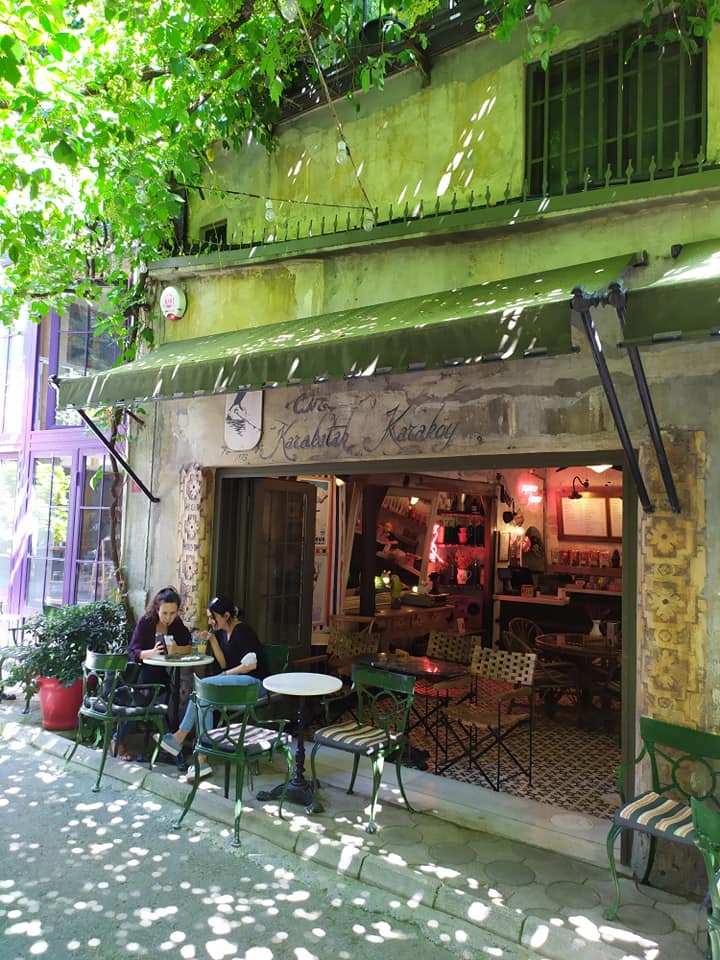“I’m steppin’ out, steppin’ ou-ou-ou-out!” The chorus to the old John Lennon song was bouncing in my ears as we boarded the ferry at Üsküdar. For the first time in a year, my wife, son and I were taking a ferry. With the city baking in heat, there seemed no better time, especially now that the restrictions were finally on their way out.
Oh, the feeling of the wind in your face, as the engines of the boat fired up, churning out white bubbles of the Bosphorus, and we set off for the distant shores of Karaköy. That was another thing: Karaköy. When was the last time we were in Karaköy? We felt like tourists in our own city.
During the twenty-minute journey, our son Leo marveled at all the boats passing by, the other ferries, the big tankers, the sailboats, all the things he had seen in his baby books but now floating past in real time. We marveled too, invested with that long-overdue sense of freedom, excitement, that we could go where we wanted to go in this great city (my wife and I have both received our first doses of Pfizer/Biontech). Of course, we still wore our masks, and kept a bottle of limon colonya close by.
****
When the boat landed at Karaköy, the Galata Tower, peering from the top of the hill, seemed to welcome us back. Stepping ashore, you felt the keen differences instantly. Nearby, a fish restaurant with breezy, ivy-covered interior, open-air, blue-colored tables and a Greek vibe beckoned, but we passed it and went through the tunnel to Karaköy proper, where you can look out at the iskele or pass into the backstreets.

Since it was mid-day and the sunlight really sharp and intense, we opted for the shady backstreets. Here, too, we savored the aesthetic and tonal differences from our home in Üsküdar. The streets here have almost an Italian flavour, and indeed I read somewhere that back in the 15th Century this area Galata, a fishing and commercial port, was modeled after Venice.
Nowadays, much of the neighborhood has been revamped, re-cast as a cultural center. There’s the Istanbul Modern along the waterline, but also a host of other galleries, small shops and lots of cafes, bars and restaurants.
For our first stop, we went to Namli Gurme, which is one of the oldest baklava restaurants in the city. Inside, one finds a lot more than baklava. The place offers shelves full of pricey and exotic goodies, from teriyaki sauce, pork bacon (at a stiff 230 TL per kilo, or something like that), to JiF peanut butter. It’s self-service inside, so we settled on fıstık baklava, tea and coffee and sat outside.
Later, we walked through the slender backstreets. Most locals and visitors were sitting at small tables outside the cafes, some having coffee or tea but others jumping into pints and cocktails (living in Üsküdar, my wife and I don’t normally have this option).
We arrived at a lovely street that was completely shaded by thick green ivy and trees. It almost felt like we were in Bozcaada for a second, or some other Aegean coastal retreat, right here in the heart of the big city. A café called Karabatak lay nestled deep in the recesses of the shady corridor. Except for the occasional motorcycle (lots of those in Karaköy, as everywhere else in the city) and casual pedestrians, the corridor felt almost deserted.
I learned that Karabatak (named after the sea bird) used to be a metal works facility, and was refashioned into a café in 2010. So the café is a prime example of urban revitalization. We ordered cay and an Americano (the bill came out to about 50 TL, so a bit pricey this urban revitalization is, I guess) and sat at the comfortable wooden chairs outside, with dappled sunlight dripping through the green leaves. Others sat nearby, chatting and enjoying the shade and sequestered location. As my wife took our son Leo to explore the nearby side streets, I sipped my Americano and thought about my friends back in Northern California and Oregon, which have been hit with a scorching heat wave in recent days, and how I was here in the shade of Karaköy, a breeze fluttering through the streets, and spending time with my wife and son.

Later, we crossed the main road near the tram stop and walked up the hill to Tophane. There was a garden there we knew, a former orphanage, that served beer. Alas, when we found it, the garden was still there, looking inviting and resplendent alongside the restored ruins of the orphanage, but the beer was no longer served. Disheartened, we settled for a limonata that almost choked you with its sourness.
By then, it was after four, and Leo was long past his nap time, but he was still quite awake and over-excited from all the new things and places he was seeing. We walked back to Karaköy, over to a long straight street with lots of cafes and restaurants. We passed Çorba Evi, or Soup House. Being “Seinfeld” fans, we couldn’t help but check the menu to see if they had Mulligatawny soup, but no, but perhaps they do have a Soup Nazi employed. “Next time,” we promised ourselves. Lots of people were out now, lots of them looking very young and fashionable. They sat at places like Chez Moi, with its French red awning, sidewalk tables and colorful drinks. We had Leo with us though so again, we would have to enjoy those pleasures some other time.
“Looks like Taksim is going down and Karaköy is rising,” my wife said, impressed. I agreed. We haven’t been to Taksim since the pandemic started, but even before that, Taksim just hadn’t felt the way it used to feel, back when I first arrived in the city in 2010. Walking through Karaköy, I too had this feeling that, with its ongoing redefined ex-commercial, now-cultural aesthetic, and all the young people out and about, that if I were young and single again, I would be saying, “Farewell Taksim, Hello Karaköy!”
****
Still, as we headed to the iskele to catch the ferryboat back to Üsküdar, my wife and I both felt tired but refreshed, exalted. It felt good to be exploring the city again, which is the whole reason one lives in a city like Istanbul to begin with. Sitting at home much of the time this past year, or at best venturing out to the same old tired streets in our Üsküdar neighborhood, one started to forget that there’s a whole city out there, whole worlds in fact, and one of the many pleasures of Istanbul is that you have so many of them just a ferry ride away.
Perhaps next time we’ll head to Balat, or Moda, or if we’re feeling saucy we’ll risk taking the funicular up the hill to see what’s shaking in Cihangir these days. Or perhaps Ortaköy, can’t recall the last time we were there, certainly long before Leo. Hell, why not Kilyos? A bit of a Black Sea day. Oh well, the summer is long and, touch wood, we’ll have our second shots soon, and we will be able to get around to these places, or others, soon enough.
James Tressler, author of several books on Istanbul and a teacher, is a long-time contributor to Yabangee.









